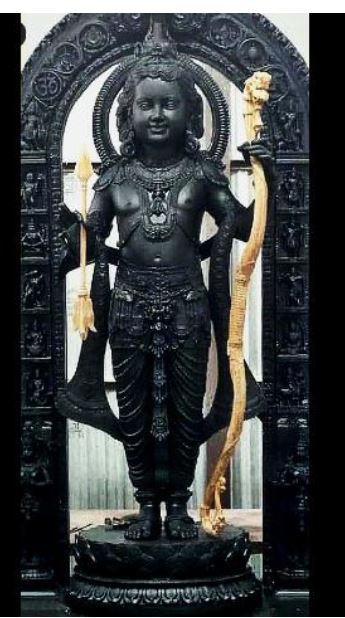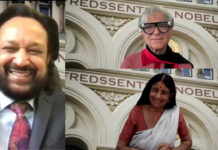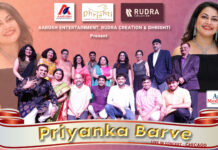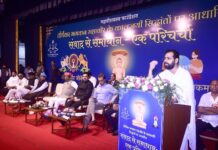Geetha Patil and Sunil Kumar D.
We all witnessed with utmost devotion the inauguration of Ram Temple in Ayodhya and Pran Pratishta of a 51-inch tall idol of Ram Lalla, showing the deity as a five-year-old boy, in its Garbha Graha (sanctum sanctorum) on Monday January 22, 2024 by our Prime Minister Narendra Modi. A three billion-year-old rare and ancient rock known for its azure-colored Krishna Shila or black schist found in Gujjegowdanapura village, Mysuru district is adding a timeless majesty and glory to the idol. Mysuru-based sculptor, Arun Yogiraj meticulously chiseled Lord Ram Lalla Murti, now graces the Garbha Griha with great sanctity.
The idol’s radiating lotus like eyes, tranquility-emitting face, and the embodiment of child-like innocence blended with divinity, and royalty have captivated the hearts of billions of worshippers and viewers. The brilliant artisanship and the artistic prowess of Arun Yogiraj made Lord Balak Ram Murti a stunning and gorgeous creation. Lord Ram Lalla adorned with Banarasi yellow Dothi and a red angavastram embellished with pure gold zari and threads featuring auspicious Vaishnava symbols –Shankh, Chakra, Padma, and Mayur. HE is ornamented with an array of special magnificent gold jewelries gold studded with diamonds and various precious stones just reflect HIS divine status.

Is Ram Lalla idol changed after Pran Pratishta?
Firstly, we need to understand the Pran Pratishta ritual and how it transforms the Murti and the temple atmosphere, The Sanskrit words Prana (life force, breath, spirit, energy) pratiṣṭhā (installing, positioning. consecrating), are used in connection with a Murti. The phrase Prana Pratishtha is a Vedic ritual used for “establishment of an idol in its vital breath” or “bringing life to the temple”. It is also referred to as Murti Sthapana (placement of a Murti inside the temple). Traditionally, this is the step when the eyes of a Murti are opened up to the public from inside the Garbha Griha (Purusha space) of a Hindu temple.
The Pran Pratishta is a live process ritual that takes place while chanting of Vedic Mantras and conch blowing that makes the Murti, or a Kalash, or even empty space a divine possibility. For such event, temple priests, Jajman, and Jajman’s family, and many devotees prepare themselves spiritually by following strict rituals. For this Pran Pratishta event, our Prime Minister Narendra Modi as the chief Jajman of the ‘Pran Pratishtha’ ceremony followed with full devotion the strictest rituals for 11 days. He not only slept on the floor, observed strict fasting by consuming only coconut-water twice a day and he even visited several Jagrat Vishnu temples in different parts of Bharat and sought their blessings. When such spiritually oriented people performed Pran Pratishtha of Ram Lalla, mystical magic spread in the surrounding areas, and transmitted through the TV screens and radio rooms globally and made all the devotees emotional and transcendental that we all noticed and experienced on January 22 event. That moment, not only devotees at the temple premise but also devotees across the globe felt the divine presence around them as they saw Ram Lalla whose eyes and enchanting smile captivated everyone. It was a beautiful, divine, and mesmerizing event beyond words! Crores of devotees along with sculptor Arun Yogiraj noticed fascinating transformation in the face of Ram Lalla soon after Pran Pratishtha.
Why is Rama Lalla idol in black stone?
This “Krishna Shila” is bluish-grey in color but when applied coconut and burnt cocoa powder it turns into black color stone. This stone was chosen because it is very durable, does not react to AbhishekamChaturvimsathiDhravyas or acids and resistant to climatic variation and will sustain thousands of years without any blemishes with minimum maintenance. Over the years, it hardens and does not react to anything. There are 5,000-year-old temples where idols have been made using Krishna Shila stones and have till now not reacted to any weather conditions.
In addition, our ancient scriptures portray Lord Rama with Shyamal Roop, signifying a darker skin complexion. Consequently, the black color of Ram Lalla’s idol aligns with the scriptural narratives, establishing a connection between the idol’s appearance and the descriptions found in in Maharishi Valmiki’s Ramayana. In Bhakti literature, Ram is called Nīlameghashyama—the one who is of the complexion of a blue-black cloud. Talking about the blue depiction of Ram according to Devdutt Pattanaik, mythologist and author, blue is the color of the sky, and of divinity. In addition, Deepam Chatterjee, the author of The Millennial Yogi, says, “Blue depicts the infinite. It is the color of the clear day sky, and of the deep sea. Divinity is often depicted as infinity. Hence, depictions of Lord Rama as blue are symbolic of HIS divine nature.” Goswami Tulsidas Ji describes Ram as “Whose body has the hue of a blue lotus, who is dark-skinned, whose body parts are soft, on whose left resides Sita…” Sometimes we also come across the depiction of Ram in fair complexion that can be considered as an “artistic imagination.
Why is the Ram idol at Ayodhya in a child form?
Ayodhya is where Lord Rama was born and thus it rightfully justifies the Ram Janmabhoomi.
That is the reason behind why the child form of Lord Rama, and devotees call him with great reverence and love as Ram Lalla/Balak Ram. HE resembles a child, whose age is five years, has been installed at the Ayodhya Ram Mandir with infinite joy and enthusiasm. In the case of the Ayodhya Ram temple, the primarily focuses on Lord Rama as the central deity. Ayodhya is not only the birthplace of Lord Ram but also the original home of Ram. HIS rule began from this spot situated near the Sarayu River. Our festival Diwali marks the end of HIS 14-year ordeal of separation from the place.
What is the difference between Ram Temple in Ayodhya and other Ram temples in South Bharat?
The Agama traditions of the south Bharat mandate the deity be made in black stone because it should not be ordinarily visible in the darkness of the Garba Griha, just as moksha is not easily attainable. It requires years of Tapas and Sadhana and the deity should only be visible during Aarti to get HIS/HER Darshan and blessings. On the contrary, in many temples of the north Bharat, the Garba Griha is well lit, and the deity is always prominently visible. There is be a good reason why temples make the deity so prominently visible to devotees. In the case of the Ram Mandir in Ayodhya, making the deity very visible to devotees is understandable, since Rama is both religious and historical figure. HE also “represents” the core deals of our civilization, dharma and Maryada, and the aspirational qualities of the Purnavatara.
Also Read: Ram temple gets online donations worth Rs 3.17 cr after Pran Pratishtha







